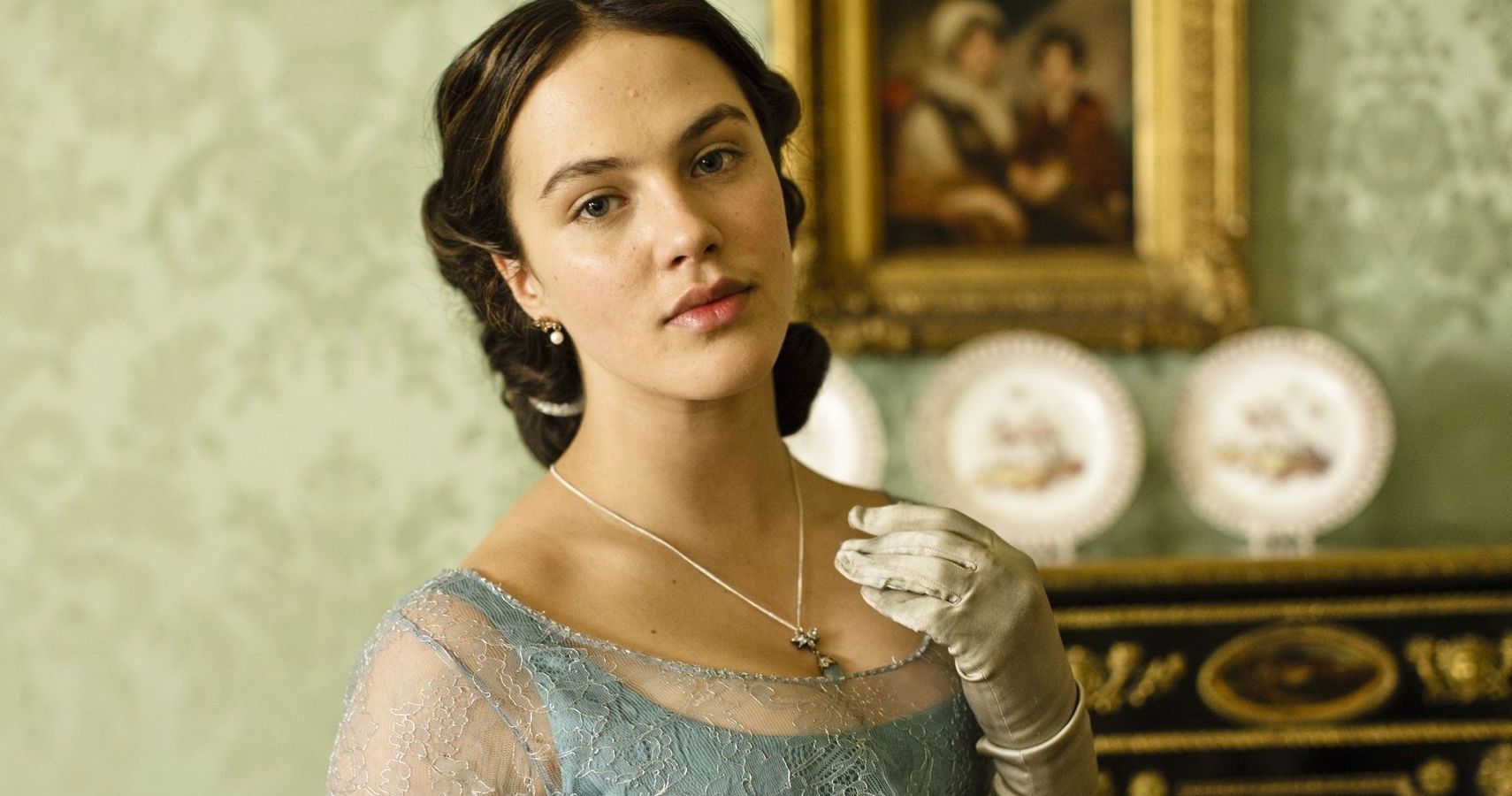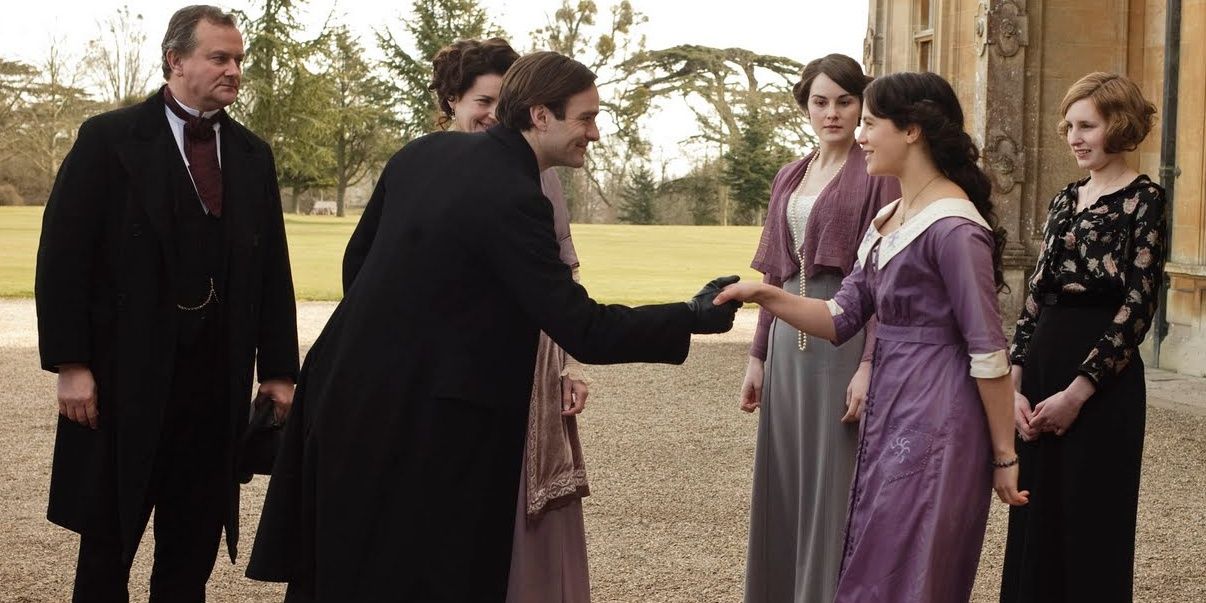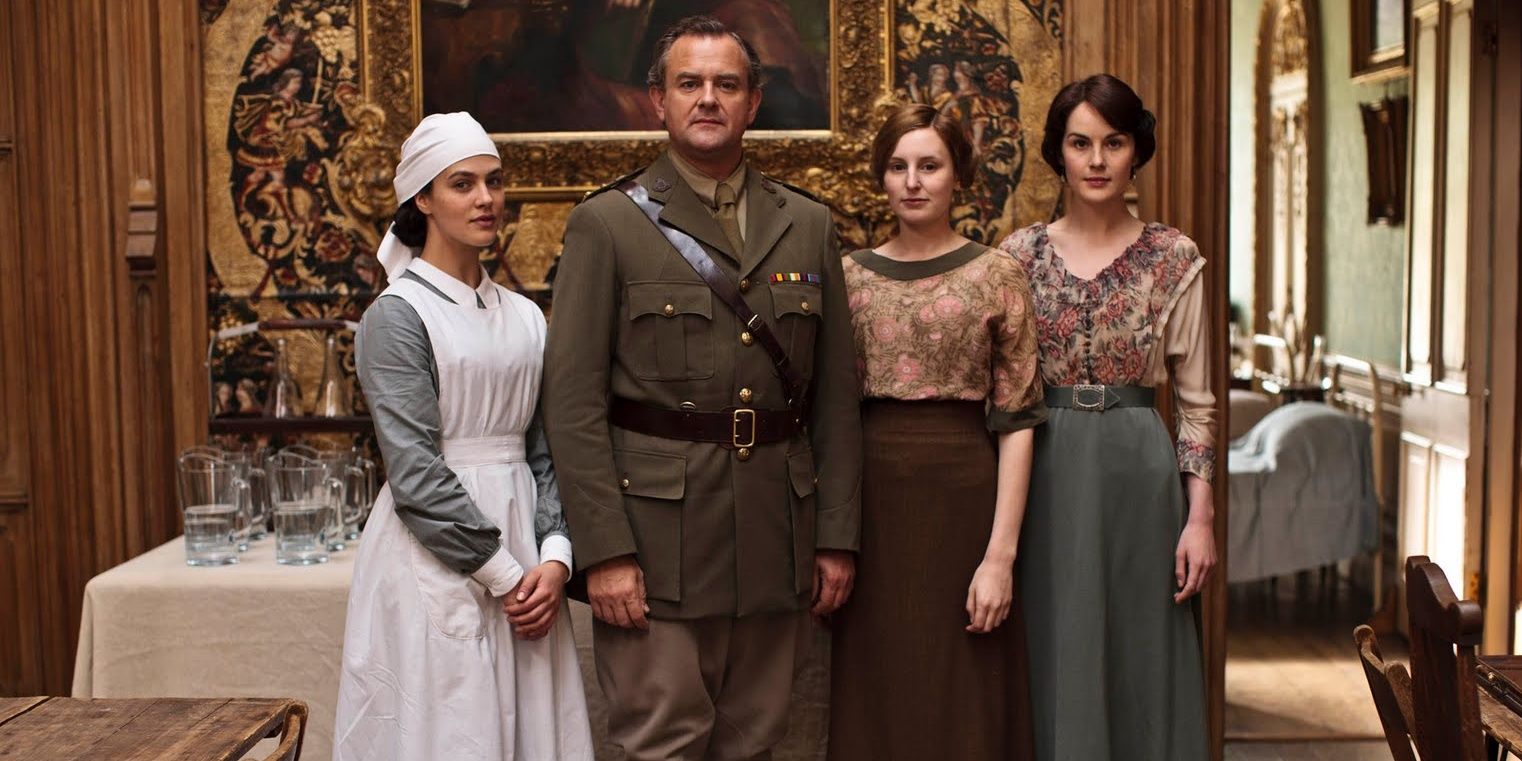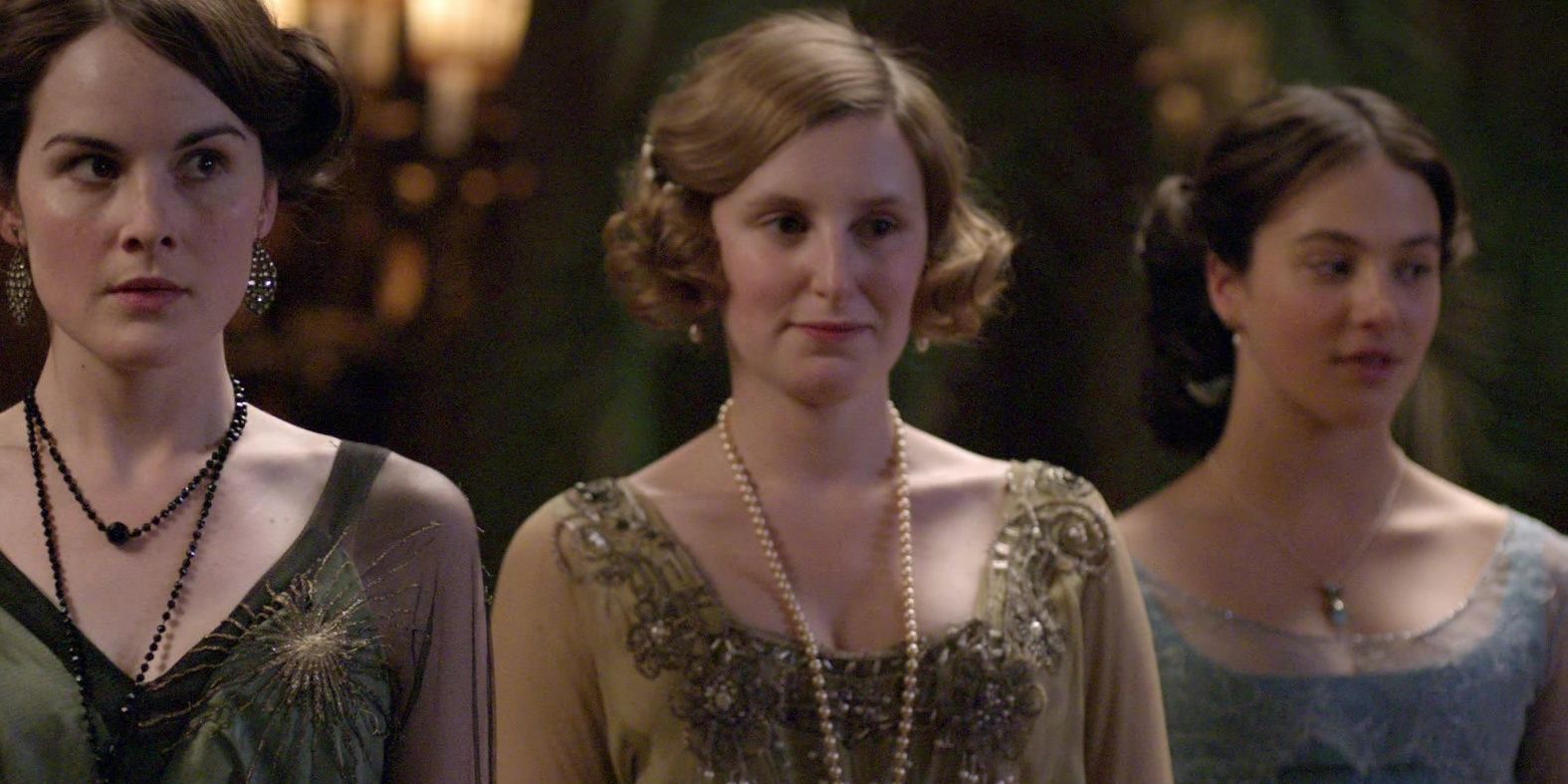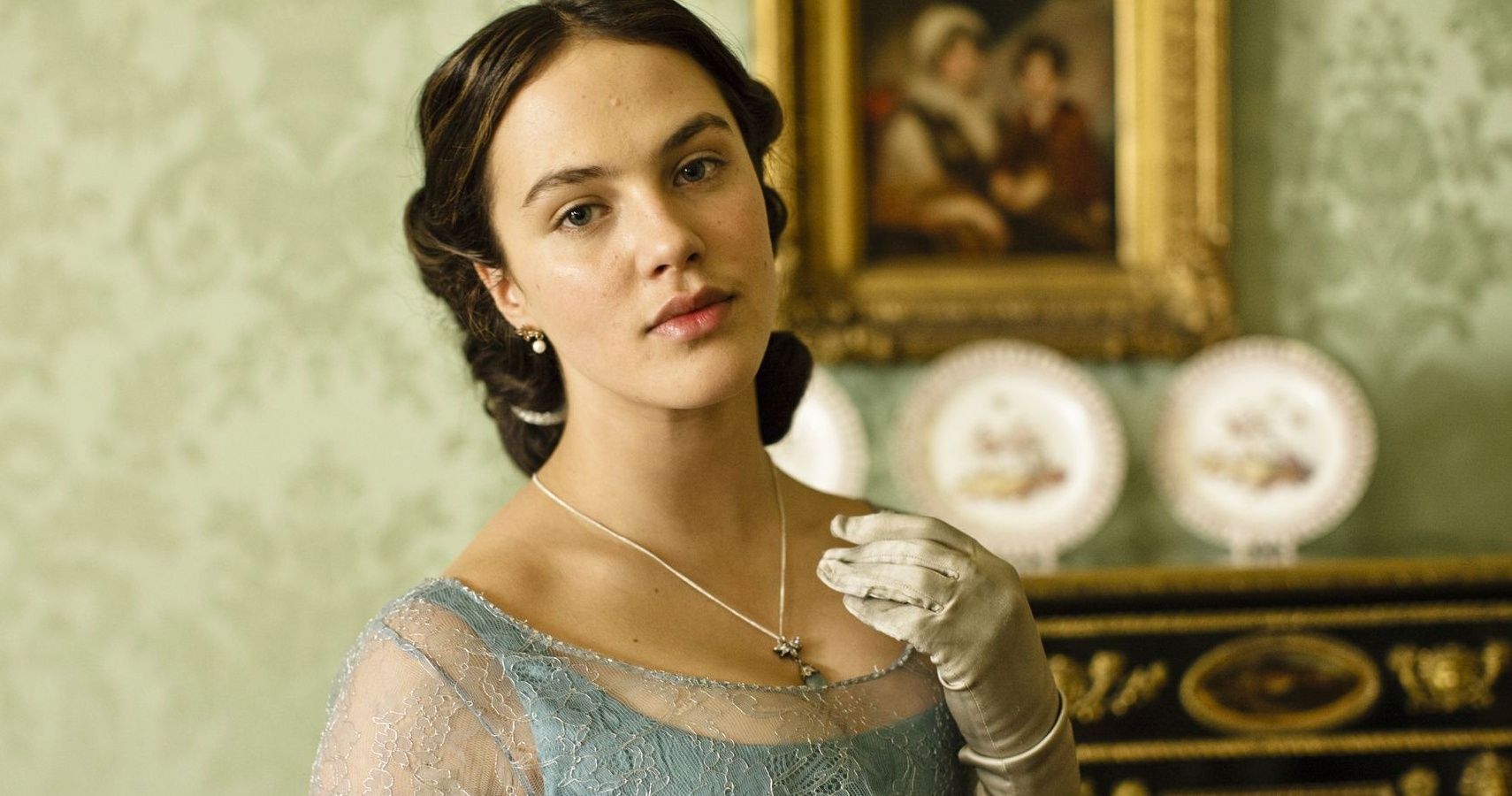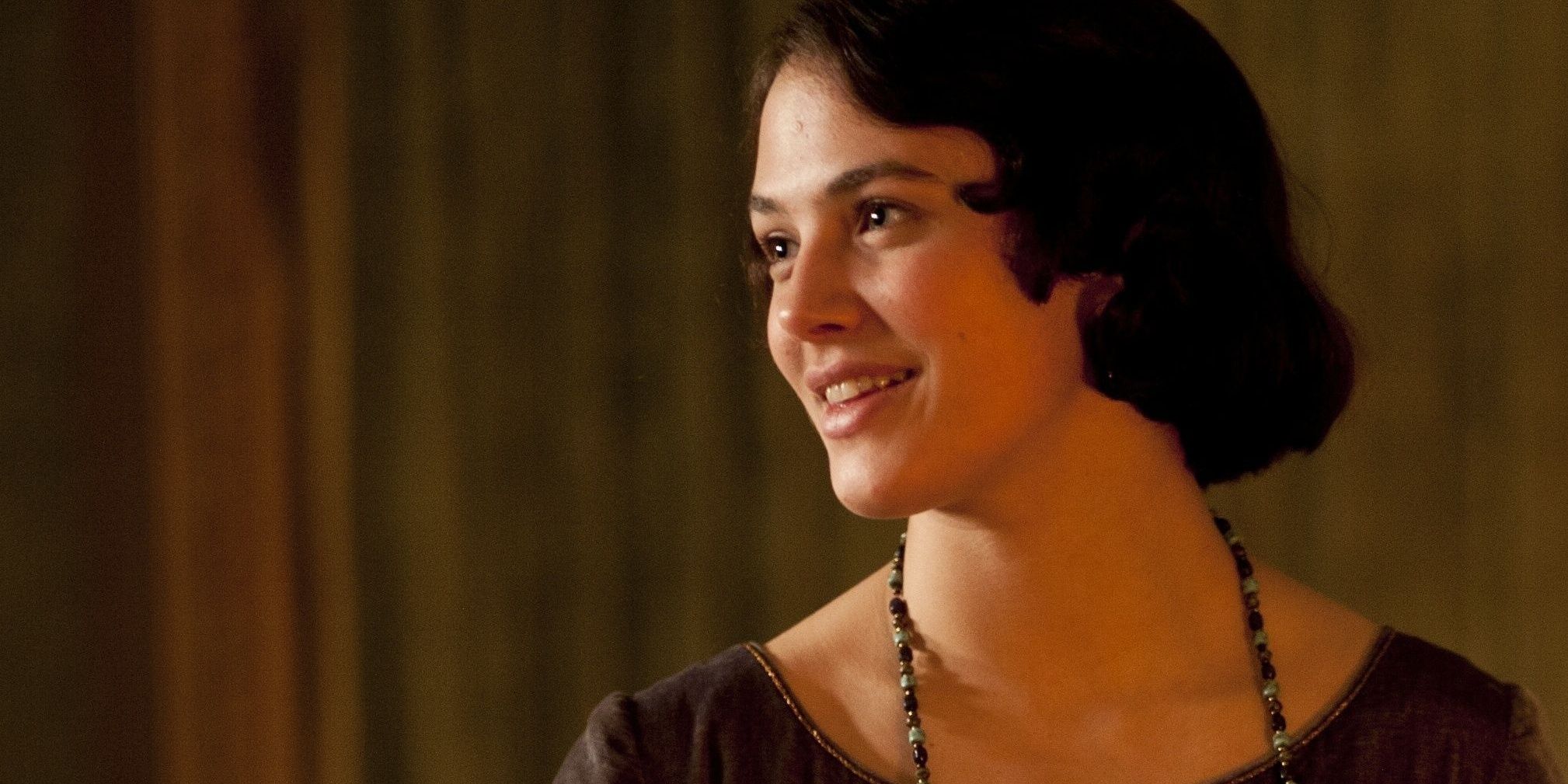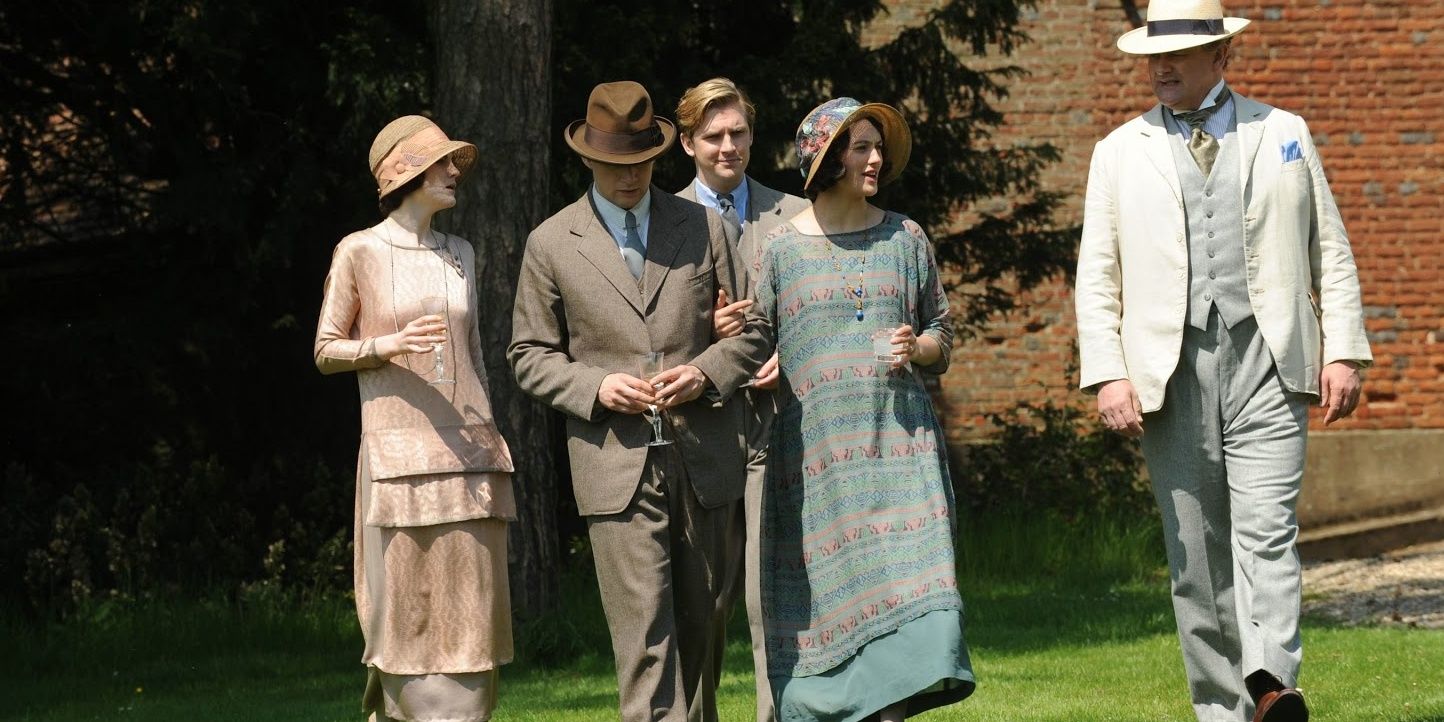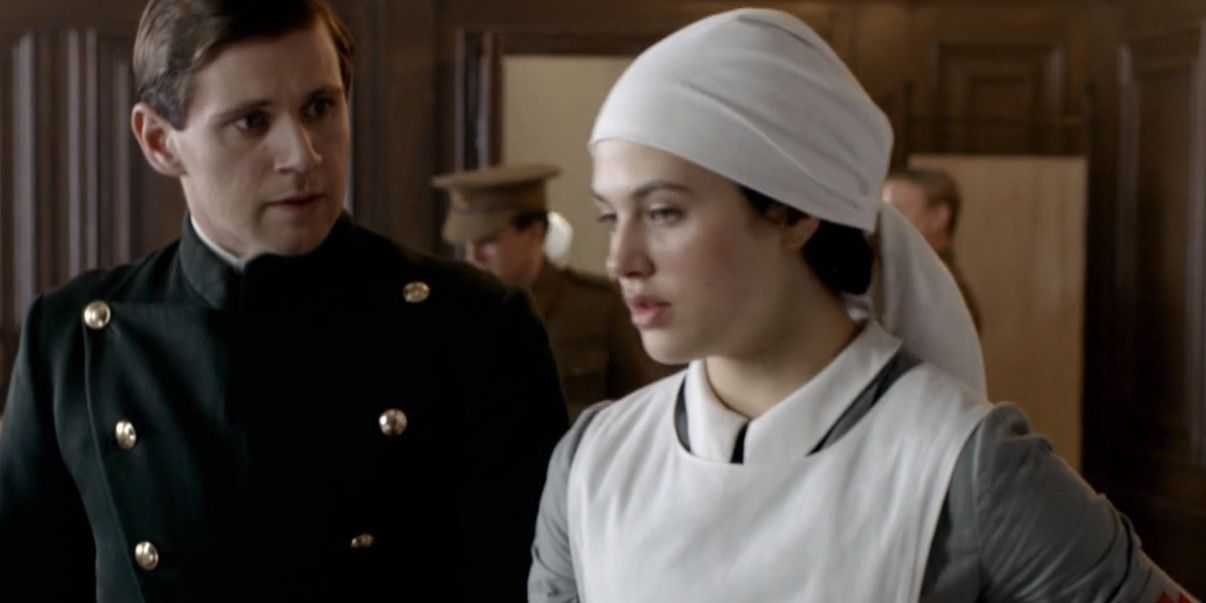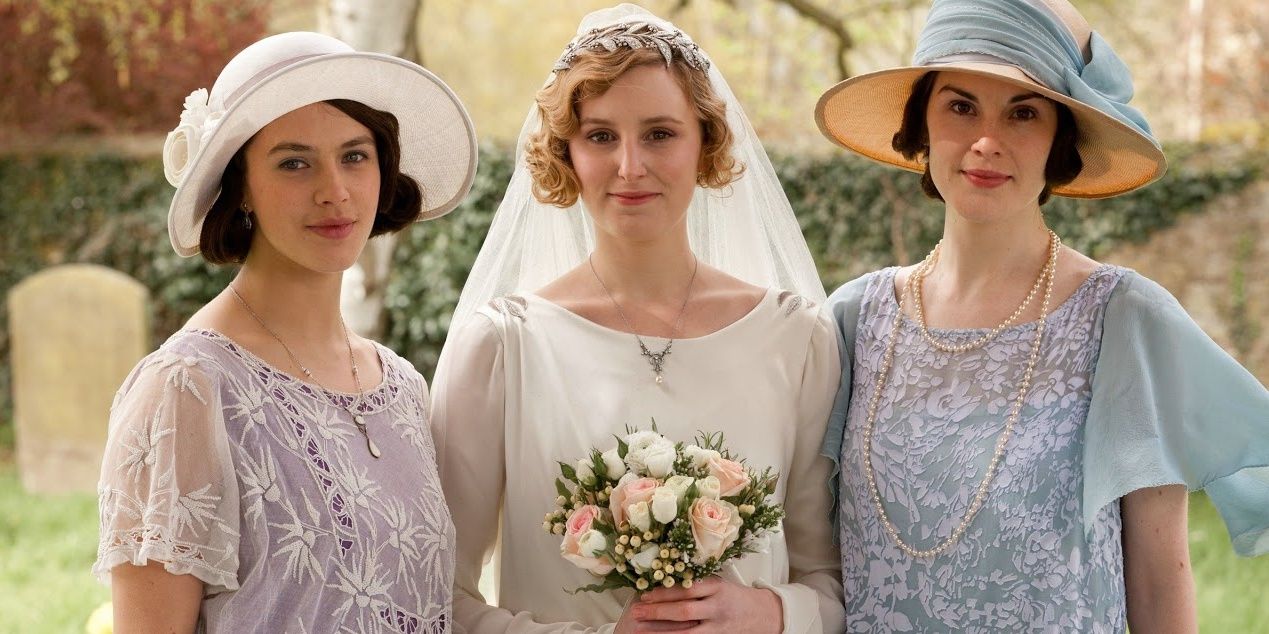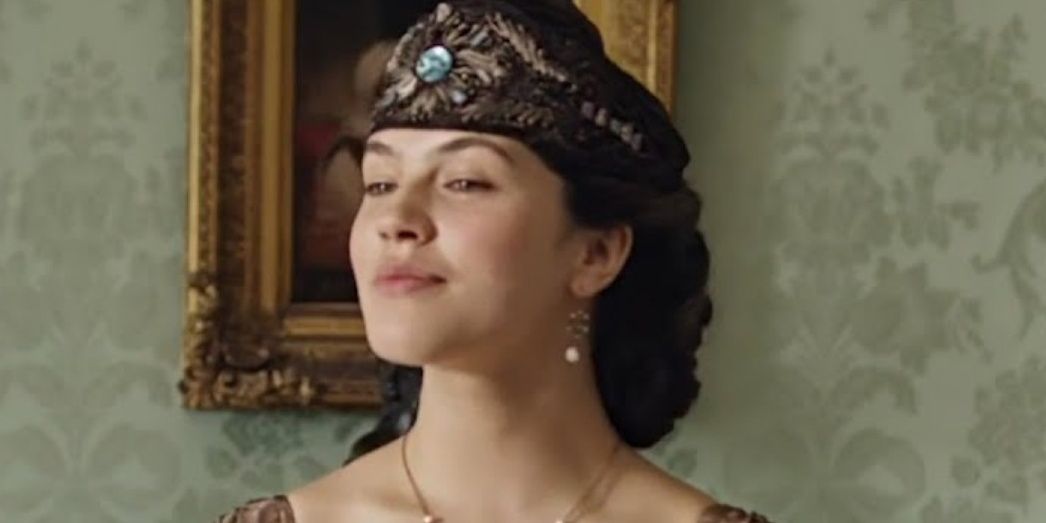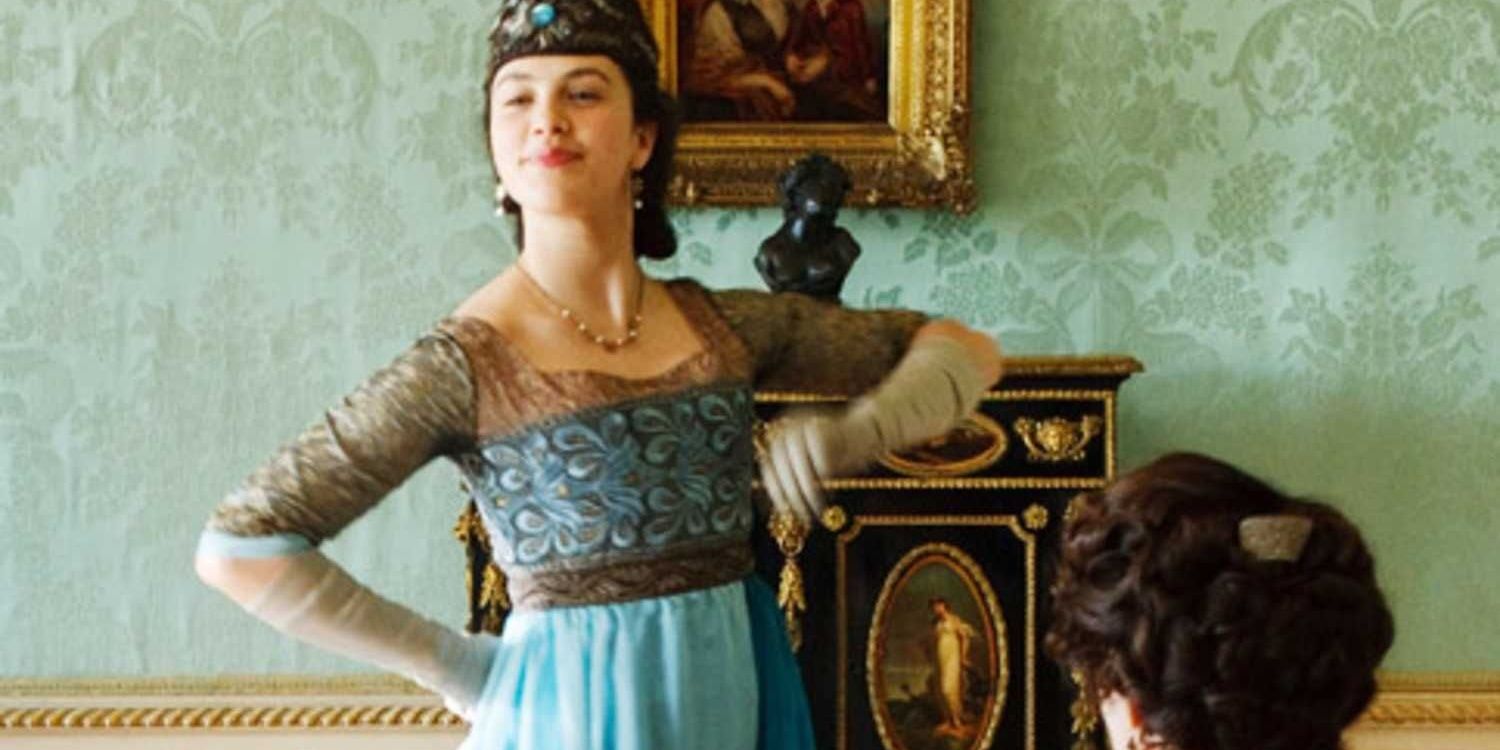Sybil Branson (nee Crawley) was one of Downton Abbey's most beloved characters. The youngest daughter of Robert and Cora, her commitment to women's voting rights, service during the First World War, and cross-class romance with the family chauffeur, Tom Branson, inspired and titillated many a viewer. After her sudden and premature death in childbirth, her legacy continued to impact the show as much as Downton heir Matthew Crawley's did, if not more.
While Sybil never had the opportunity to wear glamorous 1920s frocks like her sisters Mary and Edith, she did have some solid looks throughout during her time on the show that spoke to her character's kind, compassionate, and forward-thinking nature. Keep reading to find out ten hidden details about Sybil's costume that you probably didn't notice.
Her hair was down in the first episode
Downton Abbey begins in 1912 with the sinking of the Titanic. It's notable that, as the youngest sister, Sybil's hair is down when Cora introduces the Crawley sisters to the Duke of Crowborough. (Note the purple day dress she is wearing with the white pointed collar.) That Sybil's hair is not in an updo shows that she is still a child by society's standards -- that is, she hasn't been presented at court and isn't yet on the marriage market.
The next episode took place in 1914, and Cora mentions that Sybil's "coming out" was a great success. The next time we see that purple day dress, Sybil's hair is definitely in adult mode.
She shared clothes with Edith
In the final episode of Season 1, Sybil is wearing a multicolored blouse with green trim on the sleeves and neckline when she asks Mary about her time in London. In Season 2, Edith is spotted wearing the same blouse while tending to injured troops at Downton.
This writer likes to think that the costume recycling was intentional and meant that Edith and Sybil borrowed clothes from each other as real sisters do. As the younger sisters, Edith and Sybil probably had more in common with each other than with Mary, who was the dominant personality of the trio.
She wore mostly blues and purples
One of the best parts of Downton Abbey's costume design is the intentional use of color, which is especially apparent in the Crawley sisters. Mary, as the dominant personality, wore mostly red and black to show her strength and demand for attention, while Edith tended to wear lighter versions of these colors to show her feelings of living in Mary's shadow.
As the peacemaker between two squabbling sisters, Sybil mostly dressed in soothing purples and blues. Her costumes convey that she is free of the toxic dynamic between her sisters, and this shows in her storyline as well. While Mary and Edith competed over eligible bachelors, Sybil was attending political rallies and helping housemaid Gwen get a job as a secretary. It's no wonder her primary colors were more self-contained.
She had a taste for the avant-garde
In contrast to Mary's high fashion tastes, Sybil aims for a more bohemian look, with unusual details that suggest her offbeat personality and political views. For instance, the print of the dress she wears to the Crawley's garden party in the final episode of Season 1 is surprisingly modern, with blue and pink geometric shapes that wouldn't look out of place on a dress from Forever 21.
There are also, of course, the billowy trousers that she wore to dinner in Season 1, which elicited many raised eyebrows from the Crawleys and one admiring gaze from Branson.
She was the first to brave the bob
Years before Mary cut her hair short out of concern for looking frumpy, Sybil arrived home at Downton with a chin-length bob for her sister's wedding. She may have had to cut her hair for more practical reasons; as the wife of a journalist, she no longer had a lady's maid to help her with the elaborate updos that had been a part of her upper-class life.
By 1927, both Mary and Edith were wearing luxurious shingle bobs with not a hair out of place, while Anna, Daisy, and Baxter sported simplified versions of the haircut that were closer to Sybil's original look.
She enjoyed newer, looser maternity styles
In addition to her shorter hair, Sybil arrives home wearing a velvet green maternity dress with elaborate embroidery that was original to the period on the sleeves and hem. At this point in Downton Abbey, it was 1920, and the popular silhouette for women was beginning to shift from the Edwardian high-waisted skirts and narrow belts to a much looser fit, discarding the corset and raising the skirt above the ankle.
Sybil would have been much more comfortable in the maternity styles of the early Jazz Age compared to Cora's experience the generation prior, when the restrictive corsets she hated were still the norm.
She wore a civilian nurse uniform
In Season 2, Sybil bravely enrolled in an auxiliary nursing course and served as a nurse during the First World War. Professionally trained nurses and volunteer nurses wore slightly different uniforms during the war to distinguish between them. The volunteer nurses, formally known as the Voluntary Aid Detachment (VAD), were initially relegated to domestic labor but were later allowed to take on medical tasks such as administering drugs.
Sybil's costume more closely resembles that of the VAD with her veil pinned at the back of the neck. The ranks of the volunteer nurses swelled with upper-class women who were dressing practically for the first time in their lives. Many found the plain caps of the original uniform design extremely unflattering and began wearing the pinned back veils instead.
Her clothes gave away her class status
At the end of Season 2, Sybil defies her family's expectations, moves to Dublin, and marries Branson. She returns to Downton for her sisters' weddings in clothes that were very on-trend for 1920. However, a closer inspection of her lilac costume at Edith's wedding reveals some wear and tear in the lace overlay, especially when compared to Mary's pristine sky blue dress.
Whether the flaws in the costume were intentional, the difference in quality points to a lifestyle that Sybil gave up to marry Branson. They may also suggest that doing so affected her relationship with the rest of the family.
She pioneered the bandeau
In later seasons of Downton Abbey, some of the upper-class women began wearing intricate tiaras low across the forehead instead of perched on the crown of the head. Lady Hexham was particularly fond of this 1920s bandeau trend in Downton Abbey: The Movie.
Before Edith, Sybil was already making waves at Downton as early as Season 1 with her new frock (later revealed as the Ballet Russes-inspired "harem" pants) and beaded bandeau headband. Her choice of trousers instead of a skirt was daring enough -- wearing something that also showed a strong foreign influence made it downright scandalous.
Her "harem" pants look had historical roots
Sybil's most famous costume took inspiration from Paul Poiret's work, which was, in turn, inspired by the Balles Russes performance in London in June 1911. Much of Poiret's work borrowed silhouettes, motifs, and colors from the outfits worn on stage, which incorporated elements of Russian costume and also allowed each dancer a full range of motion.
Poiret advocated to make the corset obsolete and usher in a new era of looser styles that allowed for more comfort. Ironically, he also popularized the hobble skirt, which closed in tight around the ankles and restricted movement. Elements of both of these designs are present in Sybil's costume, with the beautiful blue color and intricate beading making it one of the most memorable looks in the series.

